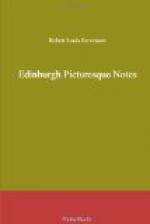Indifferent buildings give pain to the sensitive; but these things offend the plainest taste. It is a danger which threatens the amenity of the town; and as this eruption keeps spreading on our borders, we have ever the farther to walk among unpleasant sights, before we gain the country air. If the population of Edinburgh were a living, autonomous body, it would arise like one man and make night hideous with arson; the builders and their accomplices would be driven to work, like the Jews of yore, with the trowel in one hand and the defensive cutlass in the other; and as soon as one of these masonic wonders had been consummated, right-minded iconoclasts should fall thereon and make an end of it at once.
Possibly these words may meet the eye of a builder or two. It is no use asking them to employ an architect; for that would be to touch them in a delicate quarter, and its use would largely depend on what architect they were minded to call in. But let them get any architect in the world to point out any reasonably well-proportioned villa, not his own design; and let them reproduce that model to satiety.
CHAPTER VIII. THE CALTON HILL.
The east of new Edinburgh is guarded by a craggy hill, of no great elevation, which the town embraces. The old London road runs on one side of it; while the New Approach, leaving it on the other hand, completes the circuit. You mount by stairs in a cutting of the rock to find yourself in a field of monuments. Dugald Stewart has the honours of situation and architecture; Burns is memorialised lower down upon a spur; Lord Nelson, as befits a sailor, gives his name to the top-gallant of the Calton Hill. This latter erection has been differently and yet, in both cases, aptly compared to a telescope and a butter-churn; comparisons apart, it ranks among the vilest of men’s handiworks. But the chief feature is an unfinished range of columns, ‘the Modern Ruin’ as it has been called, an imposing object from far and near, and giving Edinburgh, even from the sea, that false air; of a Modern Athens which has earned for her so many slighting speeches. It was meant to be a National Monument; and its present state is a very suitable monument to certain national characteristics. The old Observatory — a quaint brown building on the edge of the steep — and the new Observatory — a classical edifice with a dome — occupy the central portion of the summit. All these are scattered on a green turf, browsed over by some sheep.
The scene suggests reflections on fame and on man’s injustice to the dead. You see Dugald Stewart rather more handsomely commemorated than Burns. Immediately below, in the Canongate churchyard, lies Robert Fergusson, Burns’s master in his art, who died insane while yet a stripling; and if Dugald Stewart has been somewhat too boisterously acclaimed, the Edinburgh poet, on the other hand,




